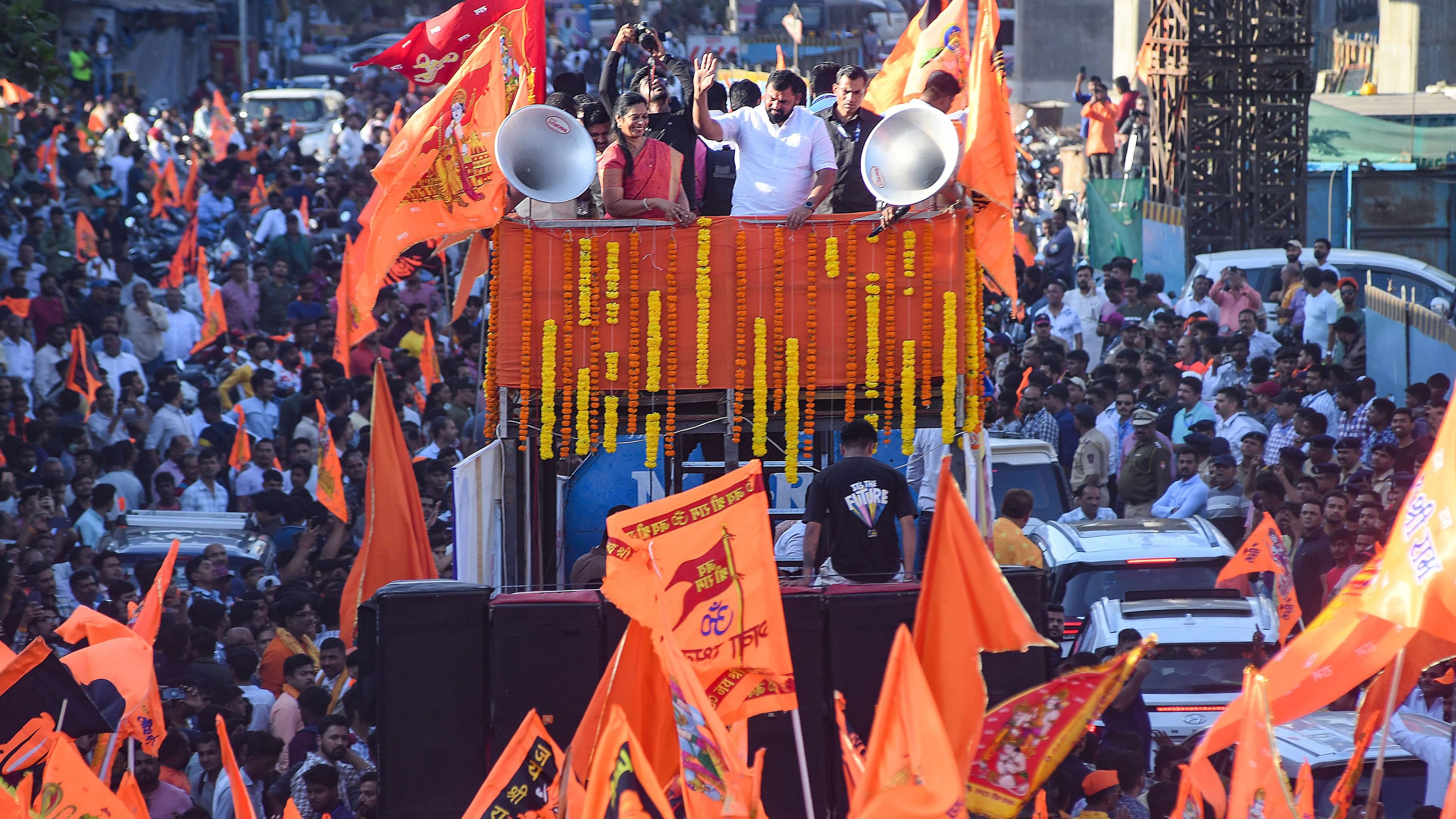
BJP MLA from Telangana T Raja Singh during a rally, at Mira Road in Mumbai, Sunday, Feb. 25, 2024.
Credit: PTI Photo-
On February 25, Mira Road, a Mumbai suburb that had seen communal violence in January, witnessed a saffron rally pass through its main thoroughfare. Though the police refused permission as it was to be addressed by T Raja Singh, the Telangana Bharatiya Janata Party (BJP) MLA notorious for hate speech, the court allowed the rally if certain conditions were met.
Conversing with the rallyists, the overwhelming majority of whom were young men, threw up several disturbing questions. How is the route of a rally permitted?
In this case, the organisers, the Sakal Hindu Samaj, had a record of organising rallies in Maharashtra wherein speeches against Muslims were given. The route they were allowed to pass through had residential buildings, shops, temples, and mosques on either side. The day chosen was a Sunday, when everyone was home. Though Mumbai’s suburbs see maximum business on Sundays, many shops downed shutters.
The mood of the rallyists was charged. They saw the rally as a display of ‘Hindu unity and strength’, which they felt was necessary to overawe the Muslims of the area.
On the eve of the consecration of the Ram temple in Ayodhya, some Muslims tried to stop a group of saffron-flag wielding bikers who they feared were out to target a mosque. One Hindu was stabbed; a day later, Muslims of the area were targeted.
The police arrested 24 Muslims, but the rallyists voiced their objection that all the miscreants hadn’t been arrested, and that some got bail. The police, they alleged, had been “bought over; we see them feasting on biryani with the local Muslims”. However, questioning them further, it became obvious that no amount of arrests would have satisfied them; what they wanted was retaliation in kind; or at least the demolition of the rioters’ homes. Of course, they were referring only to Muslim rioters.
Songs valorising ‘Hindu warriors’ who would annihilate those who messed with them, played at full blast through the rally, accompanied by shouts of ‘Jai Sri Ram’ and vile communal abuses. The climax came in the form of Singh’s speech, which was, expectedly, replete with abusive terms for Muslims and exhortations to fight for a ‘Hindu Rashtra’.
The condition laid down by the court — no hate speech — had clearly been violated. It wasn't just Singh's speech; the rally itself was a four-hour display of hate played out in full public view. The police was out in force, but had a section of the 5,000-strong frenzied crowd run amok at the sight of a mosque or a Muslim, could the police have managed to contain them? Can a mob of 5,000 young men carrying flagsticks, be stopped by a few hundred lathi-wielding policemen? Would the police have opened fire? No, if one goes by the record of the police when faced with a violent majoritarian mob.
The question that arises is, why was such a potentially explosive situation allowed? Why couldn’t the police, who knew the ground situation, convince the court that its refusal of permission for the rally was based on valid fears, not just on Singh’s record?
It can be argued that the rally acted as a vent for the anger of the Hindu youth, which might otherwise have been expressed in more damaging ways. Anger after a communal riot is natural. But once arrests have taken place, what remains to be angry about? The irony is that as usual, the police arrested more Muslims than Hindus in a clash in which both communities were attacked, yet, it was ‘Hindu anger’ that was allowed to be expressed. Would a rally by Muslims expressing anger against unequal arrests have been allowed?
Who is responsible for this anger? Who has popularised the concepts of ‘retaliation’ and ‘bulldozer justice’? It was way back in April 2014, when Narendra Modi’s prime ministerial campaign was in its final stage, that Amit Shah described the election in Muzaffarnagar, which had witnessed riots a few months earlier, as an opportunity to ‘take revenge for the insult, to teach a lesson…’. Then BJP spokesperson Nirmala Sitharaman praised Shah’s speech as capturing ‘the mood of the nation’. Since then, we have heard ministers exhort voters to ‘goli maro saalon ko’.
The disregard for the law expressed by the rallyists on February 25, thus, was only a reflection of the values encouraged by India’s ruling party, including its ‘Bulldozer Babas’. The lynching of UP’s Inspector Subodh Singh in 2018 by cow vigilantes was a vivid expression of such disregard. His assailants got bail. Has the BJP considered the possibility that a day may come when some decision by a BJP government that angers these youngsters might invoke the same contempt for the law and the police?
(Jyoti Punwani is a senior journalist.)
Disclaimer: The views expressed above are the author's own. They do not necessarily reflect the views of DH.